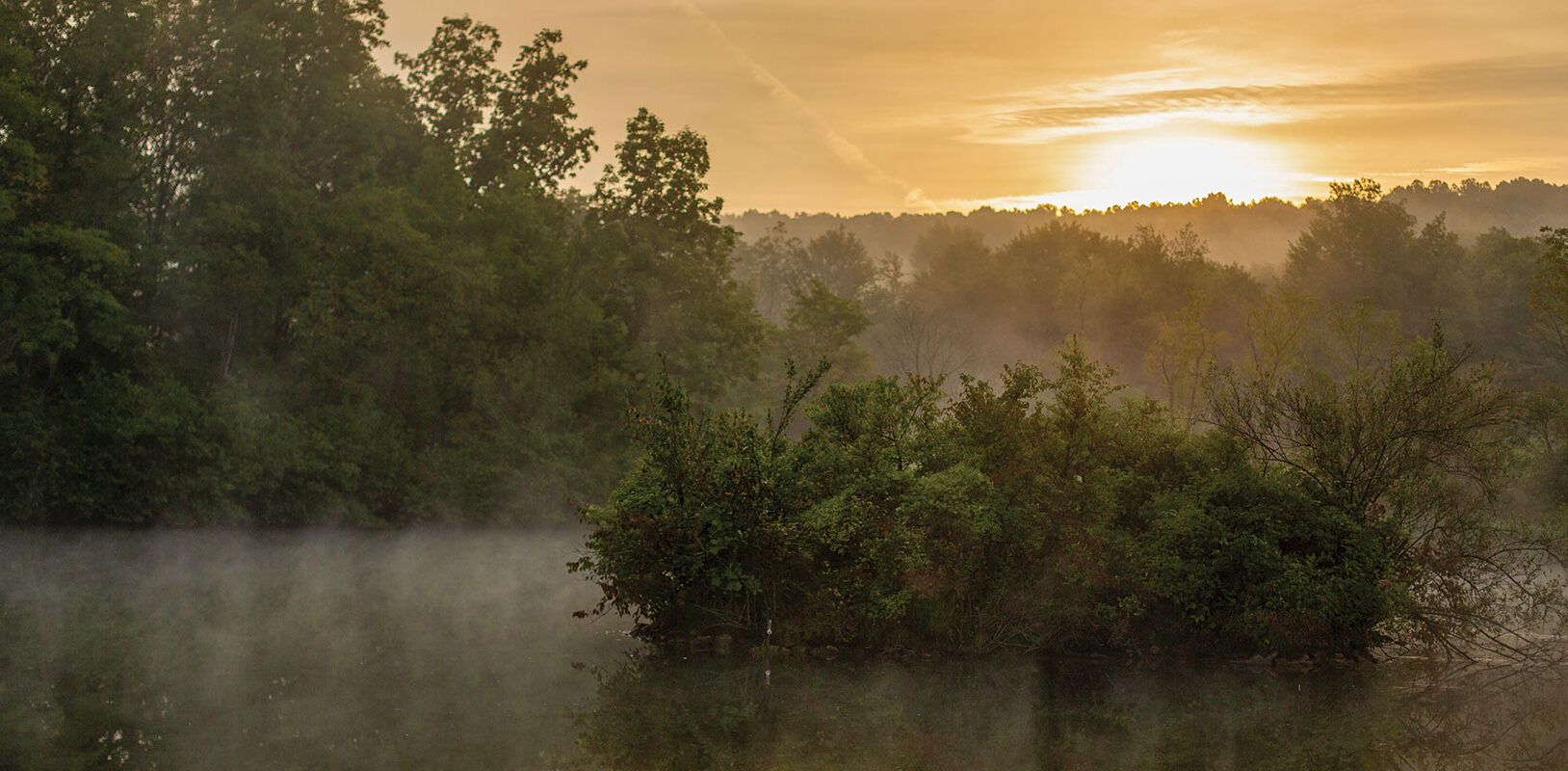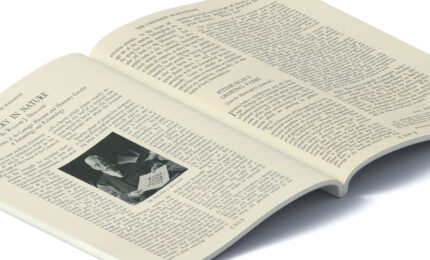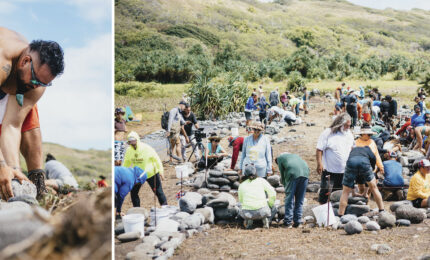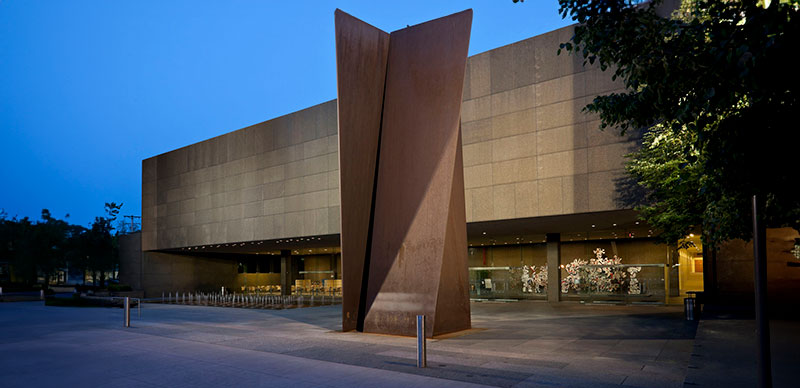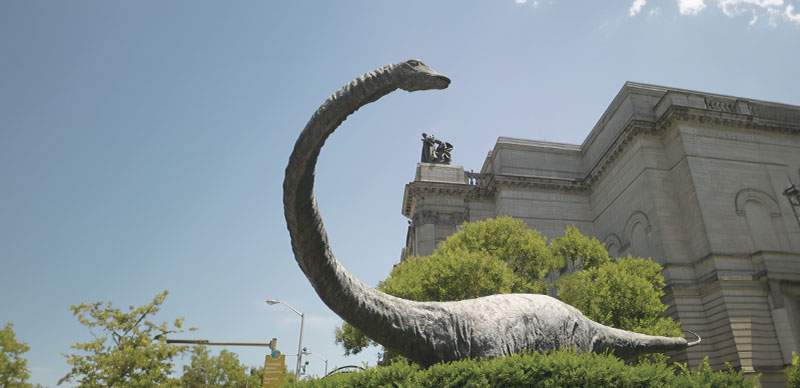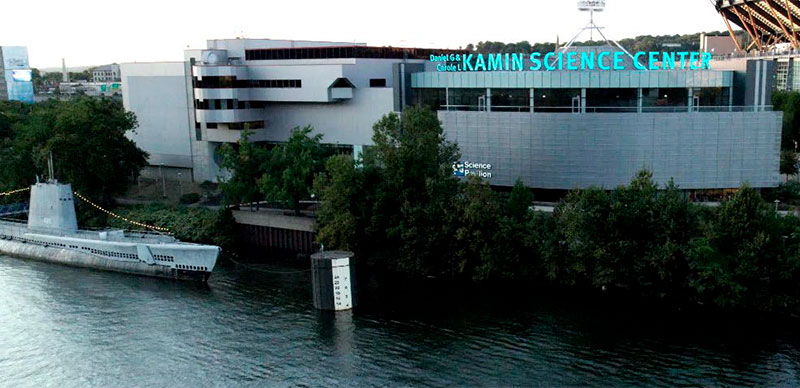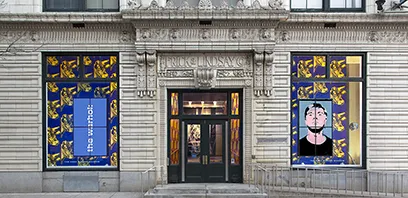It’s a cloudy morning in early April at Powdermill Nature Reserve, Carnegie Museum of Natural History’s environmental research center in the Laurel Highlands, and the bird-catching nets are up—just as they’ve been for every spring and fall migration for the last 61 years. A few steps ahead, bird-banding program manager Annie Lindsay splashes through the muck on her way to a tiny animal hanging upside down in the netting.
“Oh yeah! It’s a Louisiana waterthrush,” says Lindsay, a lanyard of brightly colored carabiners dangling from her neck. Then, perhaps sensing her own reaction, “I know, it just looks like a little brown bird. But this is a species that has been studied pretty extensively here at Powdermill.”
As she works to disentangle the bird’s wings, claws, and beak from the 10-foot-tall net—one of more than 60 deployed each morning to collect wild birds for scientific purposes—Lindsay explains that Louisiana waterthrushes nest on stream banks, like those of the nearby Powdermill Run. Watch closely, and you might even see these interesting little birds walk along the water’s edge, flipping over leaves in search of insect larvae, crustaceans, and other macroinvertebrates.
A small, metal band on the bird’s left leg reveals that it’s not the first time this particular waterthrush has wandered through the area. Most banders put the bracelet on the right leg. But at the Powdermill Avian Research Center (PARC), it’s been tradition to go with the left since the late legendary Robert (Bob) Leberman founded the bird-banding program back in 1961.
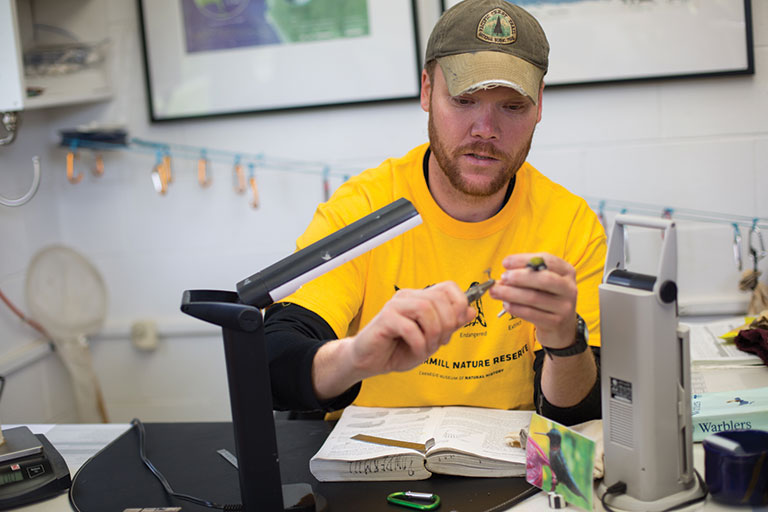
Lucas DeGroote bands a chestnut-sided warbler. | Photo: Pam Curtin
“I can tell that this bird was banded in a previous year because it has an older band number. It returned and will probably breed somewhere near here, which provides interesting information about breeding site fidelity,” Lindsay says as she carefully places the waterthrush in a soft cotton bag for transport back to the center.
Once there, the bird is weighed, measured, and checked for overall health indicators, such as the presence of fat on its underbelly. Then, depending on the species, it may have a feather plucked in order to sample its DNA; and it might even participate in a test in the standalone flight tunnel located just outside the banding building. There, PARC staff test various kinds of UV-treated glass or glass adorned with finely patterned decals in the ongoing effort to develop bird-safe glass.
On a busy day, the avian researchers process as many as 500 birds, which is part of why the center is known throughout the world for its bird-banding research. Another critical factor is longevity, as PARC is the longest-running operation of its kind in the country. In fact, last August the center celebrated processing its 800,000th bird—a staggering number by any standard.
Lindsay and Lucas DeGroote, PARC’s longtime conservation scientist, have vast experience collecting data from so many birds, which is something they pass on to other bird banders who travel to the avian research center from as far away as Alaska and Argentina to attend workshops.
Learning From The Birds
Researchers have used Powdermill’s mountain of bird-banding data over the years to discover all sorts of things about the world around us and how it’s changing.
For instance, targeted studies of Louisiana waterthrushes reveal that this species is an excellent indicator of stream health. “And as Pittsburgh has cleaned up or reduced industry, their populations are doing better,” DeGroote says.
Powdermill’s bird-banding records have quite a bit to tell us about global warming, too. “Birds are breeding earlier than they used to, and more quickly upon arrival,” says DeGroote.
Using Powdermill data, DeGroote and postdoctoral researcher Molly McDermott found that as each decade passed, birds bred an average of three days earlier, likely as a result of climate change. That’s the kind of difference you’d probably never notice looking at your backyard feeder, but when it’s wrought out over more than half a century—using tens of thousands of birds caught at Powdermill—it reveals a change of around three weeks.
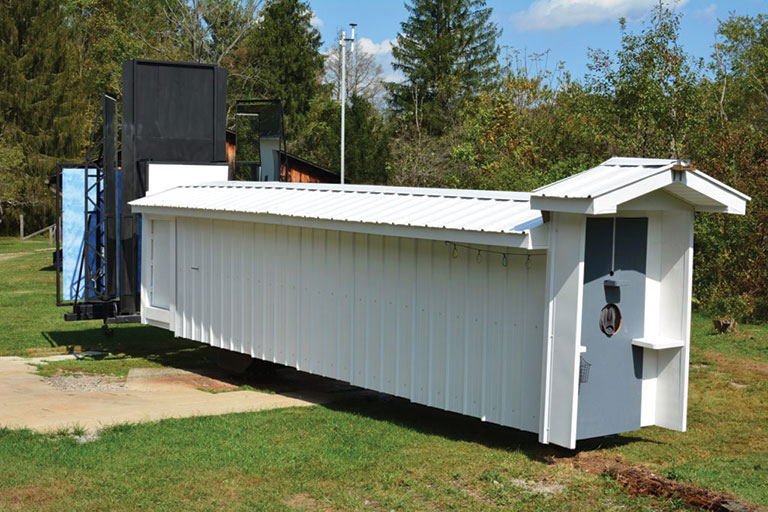
The flight tunnel at Powdermill, used to conduct bird-friendly glass research.
“Since we now know that up to a billion birds die every year in North America alone, we need a way to quickly identify glazing, films, or other patterns on glass that birds avoid. The flight tunnel offers a way to safely test many prototypes that can be rated and installed in under a year.”
-Lucas DeGroote, avian research coordinator at Powdermill Nature Reserve
Likewise, Powdermill’s bird-friendly glass research, which DeGroote and company conduct in partnership with the American Bird Conservancy, has yielded more than 120 different window products that can reduce collisions by 50 percent or more, says DeGroote. For this research, the banders release birds one by one into a short, enclosed flyway with two panes of glass on the end that are positioned just before a mirror, which reflects the sky. Thinking they see a way out, the birds then fly toward what they think is the sky. But before they reach the end of the tunnel they must make a choice between the panes of glass—one of which has been treated with an ultraviolet coating, decals, or some other product designed to help birds avoid colliding with windows. A camcorder documents the bird’s choice just before it flies into a safety net. Then the researchers open a small door and let the bird fly away unharmed.
“Since we now know that up to a billion birds die every year in North America alone, we need a way to quickly identify glazing, films, or other patterns on glass that birds avoid,” says DeGroote. “The flight tunnel offers a way to safely test many prototypes that can be rated and installed in under a year.”
These are just a sampling of the ongoing projects that make Powdermill unique.
“Few natural history museums in the U.S. have a field site like Powdermill,” says Gretchen Baker, who was named Daniel G. and Carole L. Kamin Director of Carnegie Museum of Natural History in early 2021. “It’s a place where the public can engage with living nature and the actual scientific research of the museum.”
With a renewed focus on public engagement and the new facility as a capstone, Baker hopes to usher in a new era for Powdermill as a destination for inspiration.
Science Everywhere All at Once
After half a century of operating out of a room the size of a storage shed, PARC will soon have a new home—a 2,859-square-foot, state-of-the-art, environmentally friendly facility that will not only allow the banders a bit of elbow room, but will solidify Powdermill as a premier environmental field station for scientific research, outreach, and education.
Seemingly simple amenities, such as bathrooms, showers, and a kitchen, will allow up to 10 researchers to spend longer days on-site when projects call for it.
“We’re hoping it’ll draw in more researchers who want to use this data and this place as we’ve done,” says DeGroote.
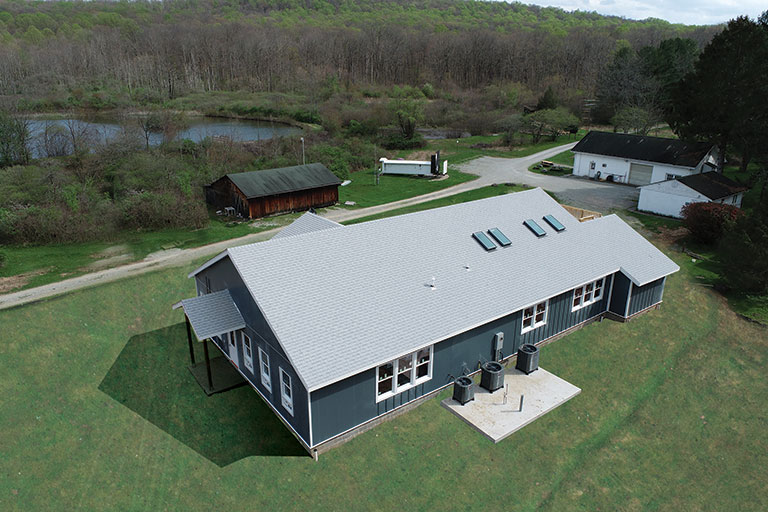
A new home for Powdermill’s bird-banding activities will accommodate more researchers and visitors.
At the same time, a public-facing seminar room equipped with TV screens and amphitheater seating for around 25 people will treat larger groups of visitors to an up-close view of bird banding. Next door, a second banding station will continue to operate outside of the public eye, so the team can simultaneously accommodate visitors without having to reduce the amount of data they collect while doing so. And with rotations to see the nets and flight tunnel, the new facility will be able to entertain up to 120 visitors at a time.
The updates couldn’t come at a better time, because Powdermill has a slew of interesting projects coming up.
In addition to the daily monitoring that PARC has become famous for, DeGroote is working to build up an even more wide-ranging bird-observation network used by scientists across the Western Hemisphere. This technology, known as Motus, allows researchers to fit individual birds with small nanotags about the size of a grain of rice. Then, anytime that bird flies near a station equipped to pick up signals from the tags, researchers can log data from that bird without ever setting hands on it again. This allows scientists to acquire data in a more proactive way, rather than waiting to see which birds return to bird-banding nets.
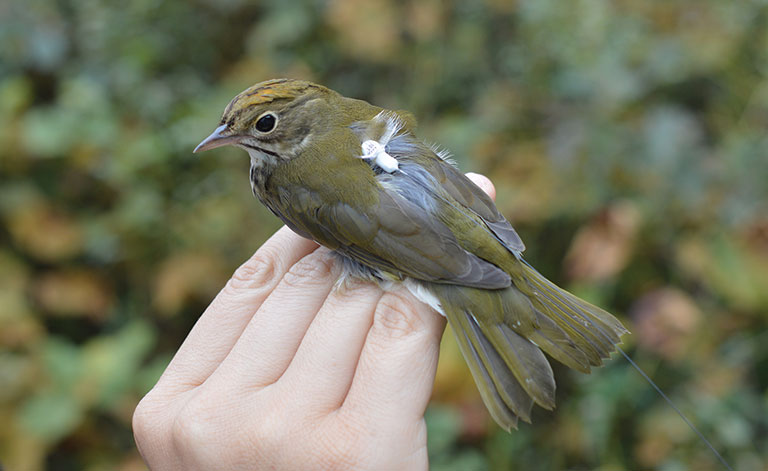
An ovenbird is fitted with an electronic tracker, known as a nanotag.
So far, DeGroote and his colleague, Jon Rice, the museum’s urban bird conservation coordinator, have installed 120 such stations across states in the mid-Atlantic and New England regions. And with the help of a new grant from the U.S. Fish and Wildlife Service, the duo will aim to construct another 18 stations across New England in the coming months. They’ve also indirectly added to the network by running Motus workshops, which have taught others the techniques necessary to construct another 50 stations.
Lindsay has also been busy updating Leberman’s seminal book, The Birds of the Ligonier Valley. Her new edition should be out this fall and will feature information about how common each species is and where to look for it. Lindsay also aims to include new species sighted in the area for the first time, such as the Brewer’s sparrow spotted in 2020, as well as quick summaries of any studies done on a given species by the researchers at Powdermill, like those completed on the Louisiana waterthrush.
Finally, the newest version will keep pace with our rapidly changing world. For instance, when writing about waterfowl species, Leberman often pinned their arrival to dates when the ice usually breaks up on bodies of water.
“But the ice doesn’t even form on some of these lakes anymore,” says Lindsay. “Or if it does, it’s not a thick sheet like in years past. We’re definitely seeing changes locally that reflect similar global trends.”
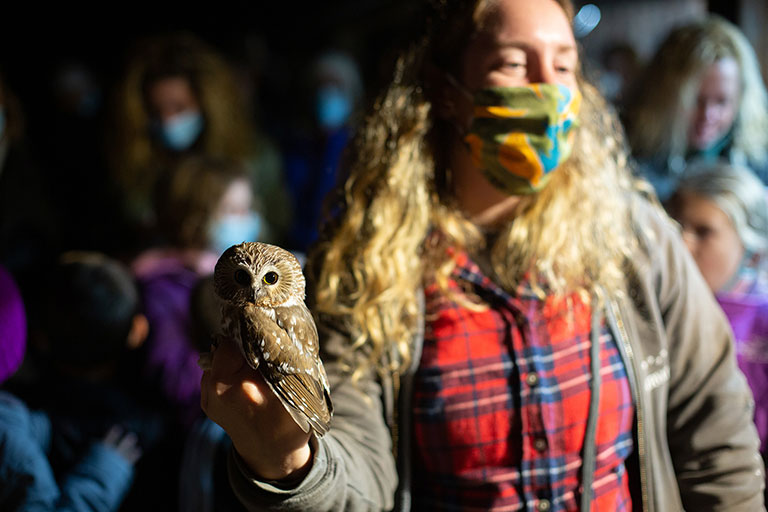
Bird-banding manager Annie Lindsay demonstrates the banding of an owl. | Photo: Pam Curtin
A Holistic Approach
Birds aren’t the only topics of interest found in Powdermill’s 2,200 acres of forests, fields, wetlands, and streams.
“This spring, we launched a new community science program at Powdermill that invites visitors to contribute their observations to better understand the changing plant phenology at Powdermill,” says Mason Heberling, assistant curator in Carnegie Museum of Natural History’s Section of Botany and co-chair of collections at the museum.
Phenology is the study of nature’s timing and cycles—when plants leaf out, bloom, and go to seed. “We have a good idea of bird migration dates over the past decades, but what about the plants many birds rely upon?” he asks.
Volunteers can take a hike along Black Birch Trail, where signs direct them on how to identify 10 focal plant species. Then, it’s just a matter of uploading their observations about bloom times, fruit development, and leaf-color changes to a free app called Nature’s Notebook so that scientists in the National Phenology Network can access them. To launch this long-term project, Powdermill hosted a series of workshops led by postbaccalaureate student Abby Yancy, who started as an education intern at Powdermill and whose position is funded through the National Science Foundation until she becomes a PhD student this fall.
“Few natural history museums in the U.S. have a field site like Powdermill. It’s a place where the public can engage with living nature and the actual scientific research of the museum.”
-Gretchen Baker, the Daniel G. and Carole L. Kamin Director of Carnegie Museum of Natural History
“We have scientific projects that look at insects, tree regeneration, invasive plants, small mammals, fish, and mollusks,” says Rose-Marie Muzika, a forest ecologist and head of science and research at the museum. “Pretty much anything you can think about, there’s been somebody who’s done a study on it at Powdermill. One of the curators at the museum, Carla Rosenfeld, is actually doing some soil and mineral research there now, too.”
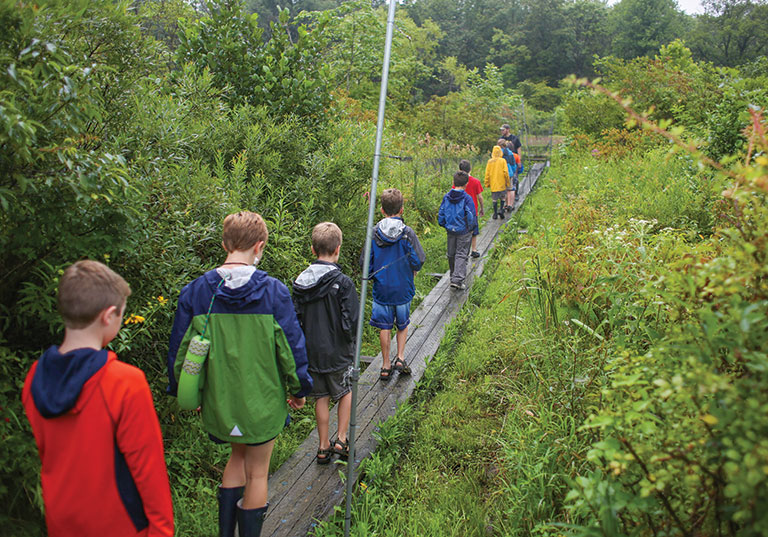
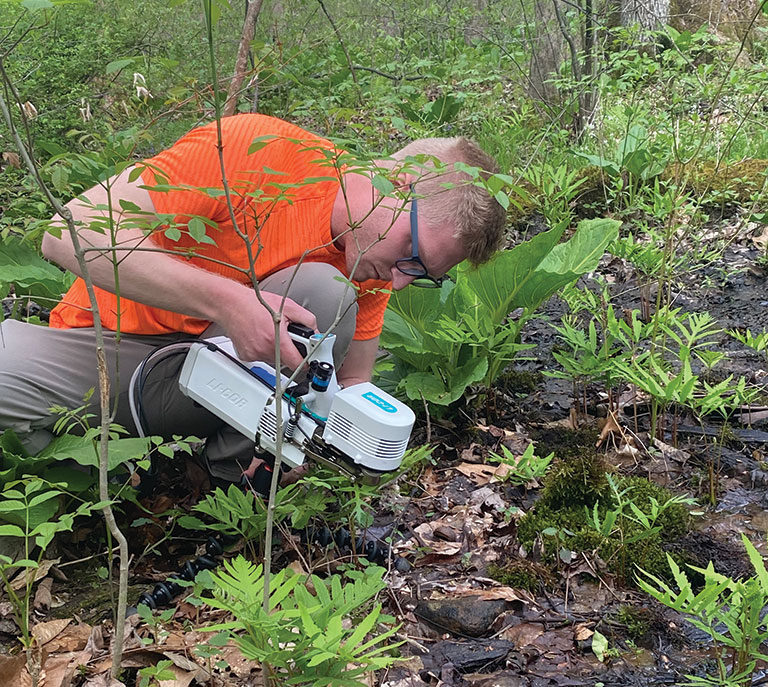
“Powdermill connects scientists, students, and bird lovers from Central America to Canada,” says Carnegie Museum of Natural History Director Gretchen Baker. The environmental research center welcomes visitors to explore its forests, fields, and streams year-round, and museum scientists like Mason Heberling (above) and other visiting scientists conduct a wide range of environmental projects there.
The most interesting research questions Powdermill can help answer, according to Muzika, are those that point to how humans have altered their environment and how forests change over time.
“It’s a unique place in the mid-Appalachians, and like almost every forest in Pennsylvania it has been totally clear-cut once, twice, maybe even three times,” she says. “But now at Powdermill we can study forests where there have been several decades without anything but ‘natural’ activity.”
Nowhere is this more evident than in a few patches of forest where a tornado ripped through in 2012. Almost perfectly, the winds tore down four large areas of forest, about five to six acres each. Often when such an event occurs, a landowner may bring in loggers to salvage the lumber. But because the blowdown happened on Powdermill land, there’s an opportunity for scientists to learn the consequences of this disturbance.
Starting in the winter of 2013, scientists from the University of Pittsburgh and the U.S. Forest Service have worked with Powdermill staff to experimentally remove some of the damaged timber. They also set up fencing that would keep deer from eating sections of the blowdowns that had been logged, as well as sections that had not. They essentially created an enormous experiment with variables and controls to figure out how forests regenerate.
To do the same experiment on private land, a state park, or even a national forest would be basically impossible.
This summer, collaborators are heading back to Powdermill for two months of exhaustive evaluation to learn what’s changed since that fateful tornado. It’ll be the first bite of a groundbreaking research project that could last decades into the future.
Eyes On the Future
Looking ahead, Muzika says there are more plans in the works to better understand the ecosystems that comprise the Powdermill property while also conducting innovative science.
Back in the 1950s, part of what is now Powdermill Nature Reserve was a farm owned by a couple known as the Friedlines. And on that farm was a small local coal mine used by the Friedlines and their neighbors. Unfortunately, drainage from that old mine had all but destroyed a small stream called Laurel Run by turning the water so acidic, it killed off all the fish and aquatic insects. Eventually, the Friedlines retired from farming and donated their acreage and its environmental issues to the reserve.
In 1997, the reserve worked with state and federal government agencies to install a passive treatment system where seepage from the mine passes through various holding ponds and filters that both suck out toxic metals and reduce the acidity of the water making its way into Laurel Run.
These systems must be continuously tweaked, Muzika explains, and the technology available for remediating acid mine drainage has greatly improved since the early 2000s. Now that it’s time for an update, Muzika says this might be a golden opportunity to show the public how science can help nature bounce back.

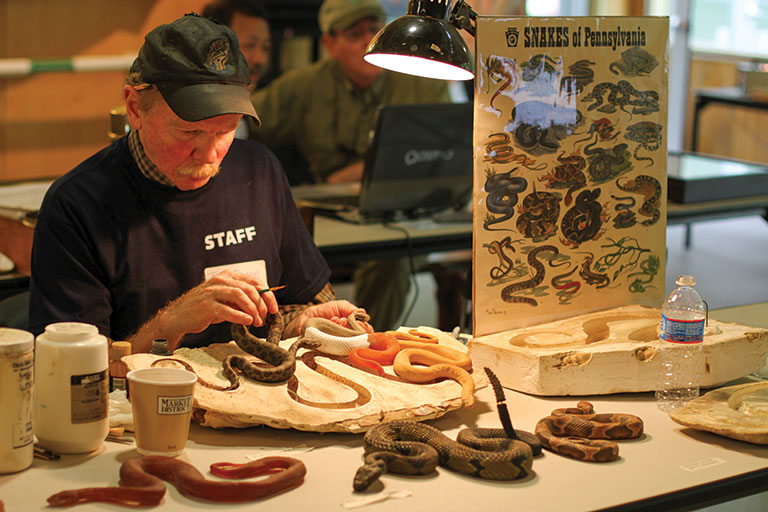
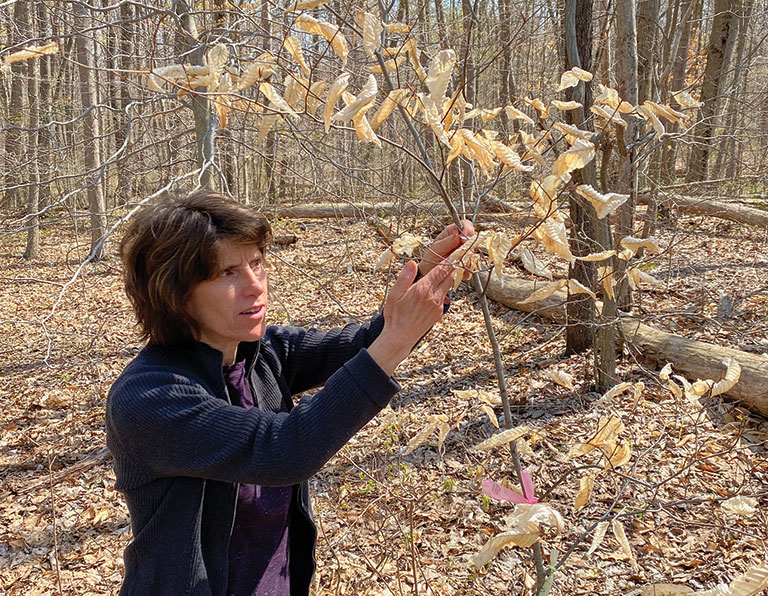
“We have scientific projects that look at insects, tree regeneration, invasive plants, small mammals, fish, and mollusks. Pretty much anything you can think about, there’s been somebody who’s done a study on it at Powdermill.”
-Rose-Marie Muzika, Director of science and research at Carnegie Museum of Natural History
“My goal is to get some scientists together to gather up some baseline data of these ecosystems,” says Muzika.
Then, after several years of construction, she plans to re-sample to learn how the process has affected deer, owls, insects, life in the soil, and any number of other quantifiable biodiversity measures.
“We want to know how our actions might enhance biodiversity through restoration, regeneration, and community science,” Baker says. “And what things can we do out at Powdermill that really involve the public in a more meaningful way?”
One thing Baker would like to see is for Powdermill to become a retreat for people who are interested in art, nature, and conservation. Whether they come alone to document and describe nature or to meet with colleagues and think together about the future, she says there are plenty of ways this facility could better connect with the community.
“Powdermill is one node on this long migratory pathway for songbirds. It’s a place that connects us to a much larger ecosystem,” Baker notes. “It also connects scientists, students, and bird lovers from Central America to Canada. The idea of migration and connectivity is a theme that I would like to explore more here at Powdermill.”
